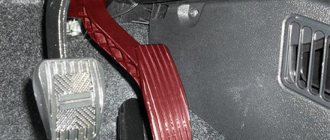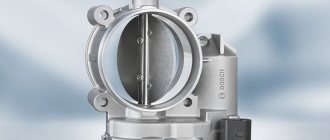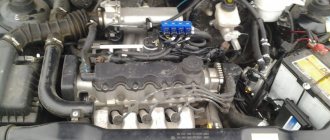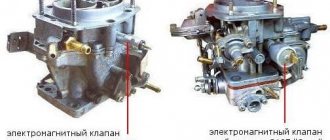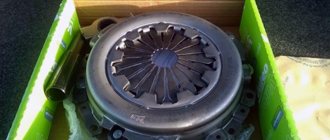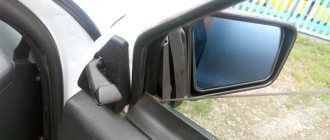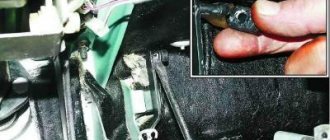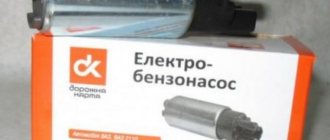On a note. All VAZ cars starting from 2011 are equipped with such a system by default. Until this year, a cable system familiar to us, but already in history, was installed with a bunch of unnecessary rubbish in the form of TPS, IAC.
Mechanical and electronic pedal
But first, let’s talk about why it was necessary to remake an old, reliable system that works without interruptions. There are several reasons for this.
When controlling the throttle position directly with your foot using a cable, there is a slight delay between opening the valve and adjusting the mixture, this leads to the following consequences:
- the wrong mixture produces a large amount of C02;
- non-compliance with EURO-5 and EURO-4 standards;
- when the gas pedal was fully pressed, much more fuel was consumed than necessary, which increases the overall consumption;
- direct control of the mixture by a person leads to the possibility of operating the internal combustion engine in critical modes at high speeds or changing the mixture too sharply, which negatively affects the service life of the engine.
In order to avoid these problems, engineers decided to protect human access to direct control of engine operating modes; in the VAZ 2114 with e-gas, the throttle valve is controlled by the ECU, taking into account the position of the gas pedal, but not 100% subordinate to it.
This allowed us to achieve:
- uniform opening of the throttle valve, without jerking;
- synchronous change in the composition of the mixture and opening of the damper;
- saving fuel and increasing engine life;
- possibility of installing anti-skid and traction control systems.
In theory, everything looks great and all the changes seem only for the better. But the electronic gas pedal of the VAZ 2114 has problems that appear because during production the device was not sufficiently tested and a crude product was released onto the market.
E-gas VAZ 2114 problems
Often the main disadvantages of electronic gas are these aspects:
- Delay in the car's response to pressing the accelerator pedal.
- Problems with floating speed, gas sticking and self-actuating.
- Impossibility of quick car tuning.
The delay is formed due to the fact that the signal from the pedal is first transmitted to the ECU and only after processing, the electric drive on the damper begins to smoothly change its position. In newer cars, this delay has been reduced thanks to better software and faster hardware. The e-gas equipment of the VAZ 2114 can also be reflashed, increasing the power and pedal response speed, but lowering the environmental standard to EURO-2.
In early versions, motorists often encountered incorrect operation of the e-gas, the speed fluctuated, there might be no reaction to the gas at all, or there could be sudden jumps in engine speed. All this was the result of faulty wiring made by AvtoVAZ; if such faults occur, it is better to replace it with a braid from PES SKK.
Cylinder selection
The first thing you will need to decide is the type and placement of the gas cylinder for your car. For example, for classic VAZ or Moskvich models in a 4-door version, it is better to use a “cigar” type cylinder, which is located behind the rear seats in the trunk. For the front-wheel drive VAZ family of three or five door modifications, the optimal choice would be to use a “Thor” type cylinder instead of a spare wheel (which will allow you to easily use the entire trunk volume with the rear seat folded).
For “Tavriy” and “Slavuta” it is best and most optimal to use a small “cigar” type cylinder located outside the car, which will allow you to “save” the useful volume of the trunk and allow you to use all the advantages of LPG.
Electronic gas pedal VAZ 2114: advantages of use and principle of operation
Since 2011, all cars produced by the AvtoVAZ concern are equipped with an electronic gas pedal, including VAZ 2114 models produced after 2011. The e-pedal has many advantages, but also due to the novelty of the mechanism used for AvtoVAZ, there were a number of shortcomings. Many motorists who bought a car with e-gas VAZ 2114 encountered problems after some time.
Electronic gas pedal
Generations of HBO: which one to install on the carburetor?
Ideal for VAZ 2106 cars with a carburetor injection system, gas equipment of the 1st or 2nd generation is suitable. Its price is not very high, there is no electronic control system, like on the 4th generation. There are not very many differences between the first and second generations. The carburetor is connected to the dispenser using a gas hose. There is a minor difference in the design of the dispenser itself. For example, the first generation uses manual dispenser adjustment. Its configuration is carried out immediately after installing the HBO. Subsequently, its position must be adjusted from time to time.
But the second generation LPG has an electric dispenser drive. It uses a specially designed stepper motor. But for this system to work, the following conditions must be met:
- the car must use an electronic carburetor;
- The exhaust system must have an oxygen sensor.
As you understand, VAZ 2106 cars do not use an electronic carburetor. Therefore, it would be more reasonable to use a conventional mechanical type dispenser; you will now learn how to install such a system. As a result, you get equipment not of the 2nd, but of the first generation.
But we can make a small reservation. If we assume that the first generation of HBO is the systems that were used half a century ago, then the second is equipment with mechanical dispensers. Therefore, the third generation is devices with electronic dispensers. The fourth generation is for working on injection engines. The fifth generation is practically a copy of the 4th, only a special pump is installed in the gas cylinder to eliminate the need to install a gearbox. The division of HBO into generations is very relative.
E-gas malfunctions
Sometimes the cause of malfunctions is a breakdown of the idle speed sensor on a VAZ 2114 with an electronic gas pedal, also called IAC. If the ECU indicates an error and the engine idle speed is too high and does not drop, mostly 2000, then the throttle assembly needs to be replaced, or you can try cleaning the terminal contacts.
Malfunctions of the electronic gas pedal of the VAZ 2114
If the electronic pedal is faulty and does not respond to pressing the accelerator pedal, and the engine speed is frozen at around 2000 rpm, do not despair and call a tow truck. With such a problem, you can move around, carefully releasing the clutch, slowly but surely you can get to your home or service center.
If you have some kind of malfunction related to the electronic gas pedal, then in the control unit you will most likely be able to find the following error codes:
- P2122 - indicates low voltage of the accelerator pedal position sensor. This sensor works on the principle of changing its resistance, and the ECU, passing current through it, recognizes it and, based on this, knows the position of the pedal. Low voltage corresponds to high sensor resistance. This can be solved by cleaning the contacts, soldering them, or replacing the pedal assembly if that doesn’t help.
- 2123 is the reverse error P2122, the voltage on the same sensor is too high. A breakdown or short circuit in the wiring, as well as failure of the sensor, is possible.
- 2127 – low signal level of the second accelerator pedal position sensor. Since this unit is quite responsible and performs an important function, it uses two sensors for accuracy and reliability. They are located in the same building, the sequence and methods for eliminating the error are the same.
- 2128 is a clone of error code 2123, only it is responsible for the second sensor.
- 2138 - the code indicates a discrepancy in the readings of these two sensors; perhaps contact has been lost with one of them or it has broken down. To solve the problem, you also need to clean the contacts, check the wiring for serviceability and test the pedal itself. The test consists of measuring the resistance of both sensors in different pedal positions and comparing the readings. If they are different, you need to change the pedal assembly.
Pinout e-gas vaz 2114
Nowadays, the electronic pedal has been worked on and most of the problems have been solved, now it works without failures, but fans of fast driving still flash their ECUs, noting improvements in the car’s response to the pedal.
This is primarily due to the fact that manufacturers are forced to impose restrictions from the factory in order to comply with EURO standards and increase engine life. Amateur firmware removes these restrictions, allowing the control unit to open the damper faster.
In Samara, and in particular with the electronic gas pedal of the VAZ 2114, problems were often encountered on models of the first years of production; after some time, the shortcomings were corrected and at the end of production, copies with reliable e-gas rolled off the assembly line.
If you find an error, please select a piece of text and press Ctrl+Enter.
What causes error p2135?
Structurally, the VAZ2114 throttle position sensor is a variable resistor, the moving contact of which is connected to the throttle valve axis. The presence of mechanical contact between the slider and the conductive layer leads to the fact that the reason for the appearance of error 2135 on the VAZ 2114 most often lies in a sensor malfunction.
Less often, an error occurs due to the fault of electrical wiring. In particular, moisture entering the contacts of the sensor connector causes them to oxidize and increase the contact resistance. Poor ground contact and broken or shorted wires may also occur.
Design and principle of operation of “e-gas”
By default, an electronic pedal consists of: an electronic damper, the pedal itself, and a chip sensor on the pedal itself. The operating scheme is as follows: when you press the accelerator, the electronic sensor amplifies the signal and transmits it to the electronic control unit (ECU), which indicates to the damper the degree of opening or closing.
If a problem occurs, the car’s on-board computer will display the following errors: P2122, 2123, 2127, 2128, 2138
.
But sometimes these transitions can't always keep up with the software.
In this regard, sensors often produce “correlation violation” errors. There are two ways to cure the problem of “dampness” in the system: Complete replacement of the chip board with a re-flashed (unlocked) one with the ability to set modes “for yourself” and regulate emissions into the atmosphere yourself. As a rule, in such situations, drivers return to Euro-2 standards
and increase engine power by 15-20% plus;
The electronic gas pedal on the VAZ 2114 is replaced with a similar new one, but the chip remains the same - not hacked, which means it will not break again for the first time.
Multivalve
Installing 2nd generation gas equipment involves selecting and installing a multi-valve. After selecting a cylinder, select the appropriate multivalve for it. Based on experience, it is best to use a class “A” multivalve with an electric coil, which can be used to shut off the supply of liquid propane-butane to the flow line.
Multivalves from Lovato and Tomasseto have performed well in operation. The multivalve must have an O-ring and screws to secure it to the cylinder. Before installing the multivalve into the cylinder, it is necessary to check the ease of movement of the float and the operation of the shut-off valves. When installing, it is advisable to lubricate the rubber O-ring of the multivalve with a thin layer of silicone grease.
The multivalve can be supplied with or without a filling device. The filling device is selected based on the customer’s wishes and the technical feasibility of installation. Refueling devices are mounted either in the refueling hatch near the neck of the gas tank (for refueling you will need to have an extension cord with you). Or you can mount the refueling device in the bumper or under it, based on the installation capabilities of a specific car model.
The filling device and the cylinder are connected to each other by a line with a diameter of 8 mm to speed up the filling process.
How to adapt the gas pedal?
We carry out adaptation either after repair, replacement of the computer, or long-term removal of the battery.
1) Connect the battery
2) Insert the key for the first time after installing the battery and turn it to the “ignition” position. The indicators on the panel light up, wait at least 30 seconds and start the engine.
Important: the temperature of the air and the engine must be at least 7 degrees warmer, otherwise adaptation is useless, the engine will operate in emergency mode.
3) Next, we adapt the ignition diagnostic function: we accelerate in second gear and brake with the engine at 4 thousand rpm. Up to 1 thousand rpm - we must perform this operation six times during one trip.
Adaptation of the diagnostic function is necessary to preserve the catalyst and possible fire. Home page
Why did AvtoVAZ need E-gas?
As I already said, environmental standards are becoming stricter every year, in order for the exhaust to comply with the standards, the cable had to be removed. This made it possible to get rid of the driver’s empty gasping, as well as other unnecessary actions that increase the toxicity of exhaust gases. The electronic pedal, as it were, regulates “at its own discretion” how to open the throttle. Even a sharp press on the pedal will be processed in such a way that as little harmful CO2 as possible is released into the atmosphere.
How it works?
An electronic pedal consists of three main elements: pedal, electric pedal. damper, as well as a sensor located on the pedal itself. The sensor reads the degree of pressure on the pedal, and then sends the data to the electronic unit. It receives the data, analyzes it and sends a signal to the electronic damper, which opens to the required degree.
What advantages does E-gas have for the motorist?
- First of all, the electronic pedal helps reduce fuel consumption.
- Despite the widespread belief that E-gas “presses” the engine, statistics show that electronics, on the contrary, improve dynamics. Although there is indeed a slight “stupidity” at the beginning.
Now about the disadvantages of E-gas
- Most often email. The pedal is criticized for its pause (“stupid”) at the start, when you press the pedal sharply and try to accelerate. According to many, the engine interacts poorly with the pedal, as a result of which approximately one second is lost. Although we have learned to correct this shortcoming.
- E-gas does not allow serious engine tuning, since the pedal negates all efforts. Installing a cable drive solves the problem. I would also like to note that we learned how to customize and customize the pedal for specific needs.
- The electronic pedal causes a lot of trouble during operation.
The main problems of E-gas
In addition to shortcomings with dynamics, other problems are also observed, for example, floating speed, “sticking” pedals, unauthorized throttle application. Main errors of the electronic pedal: (P2122-P2123, P2127-P2128, P2138).
In the office AvtoVAZ reports that when replacing the controller or removing the battery terminal, the electronic pedal requires adaptation.
Engine Lada Vesta
Products from the Dustershop77 range on the topic of the article:
| Name | Manufacturer | Price | Availability | Add to cart |
| DC1300-20182 | Throttle valve gasket kit K4M/F4R (large+small) ROSTECO | Analogue | 500 / 350 rub. Discount: 250 rub. | >10 |
| DC1822-8200291355 | Crankcase gas recirculation valve Renault 8200291355 | Original | 6900 / 6200 rub. Discount: 5900 rub. | 3 |
| DC380-ASAM-30376 | Lower radiator support cushion 7700430992 / 215081131R ASAM-SA 30376 analogue | Analogue | 150 / 100 rub. Discount: 80 rub. | 3 |
| DC1211-8200132254 | Fuel injector for K4M engine original 8200132254 | Original | 2200 / 1900 rub. Discount: 1600 rub. | 4 |
| DC919-226A41772R | Oxygen sensor lambda probe upper Duster, Vesta and other engines. H4M 1.6 226A41772R / 226901841R / 226906393R | Original | 4500 / 4200 rub. Discount: 3900 rub. | 5 |
| DC619-8200048024 | Expansion tank cover original Renault 8200048024 | Original | 700 / 500 rub. Discount: 300 rub. | 2 |
| DC981-FCR210114 | Electric fuel pump FRANCECAR FCR210114 | Analogue | 1500 / 1200 rub. Discount: 1100 rub. | 2 |
| DC1200-BK64105/30598 | Fuel pump ring with gasket | Analogue | 1000 / 700 rub. Discount: 500 rub. | 1 |
| DC1398-30777 | Gasket for fuel pump ring ASAM 30777 | ASAM | 300 / 200 rub. Discount: 150 rub. | 1 |
| DC1746 | Membrane of the crankcase gas recirculation valve Renault Duster, Captur, Terrano, etc. (KVKG membrane F4R 2.0) | Analogue | 2200 / 1700 rub. Discount: 1500 rub. | 3 |
| DC1322-224332428R | Ignition coil 1.6 H4m original 224332428R | Original | 2900 / 2500 rub. Discount: 2100 rub. | 2 |
| LRT-002/6001548140 | Washer reservoir is not original, ANALOGUE 6001548140 | LOGEM | 1000 / 900 rub. Discount: 500 rub. | 1 |
| DC382-ASAM-30494 | Expansion tank ASAM-SA 30494 (7701470460) | Analogue | 1000 / 700 rub. Discount: 600 rub. | 1 |
| DC1766 | Throttle valve gasket repair kit K4M/F4R (large+small) Balakovo PTP64 | Analogue | 300 / 200 rub. Discount: 150 rub. | 1 |
| DC1314-135101KT0A | Front crankshaft oil seal H4M original 135101KT0A | Original | 900 / 700 rub. Discount: 550 rub. | 2 |
| DC1320-161191KA1B | Throttle valve H4M original 161191KA1B | Original | 25000 / 18900 rub. Discount: 17900 rub. | 1 |
| 6001548140 | Washer reservoir Renault 6001548140 original | Original | 2000 / 1700 rub. Discount: 1500 rub. | 1 |
| DC918-226A44171R | Oxygen sensor lower lambda probe H4M 1.6 Lambda probe Renault 226A44171R | Original | 11000 / 10500 rub. Discount: 9900 rub. | 1 |
| DC955-150100565R | Oil pump for F4R original 150100565R | Original | 5500 / 4800 rub. Discount: 4400 rub. | 1 |
| DC957-8200665520 | Starter K4M 1.6 original 8200665520 | Original | 12000 / 9900 rub. Discount: 9500 rub. | 1 |
| DC1302-166008992R | Fuel injector for H4M engine original 166008992R | Original | 3500 / 2600 rub. Discount: 2400 rub. | 4 |
| DC1315-122791HC0A | Rear crankshaft oil seal H4M original 122791HC0A | Original | 2000 / 1700 rub. Discount: 1400 rub. | 1 |
| DC1889 | Upper radiator support cushion 215060007R analog | Analogue | 340 / 250 rub. Discount: 200 rub. | 1 |
| DC1682-6001549070 | Fuel vapor absorber original 6001549070 | Original | 4000 / 3200 rub. Discount: 2800 rub. | 2 |
| DC1663-21120370501015 | Ignition coil VAZ 1.6/1.8 21129/21179 original 21120370501015 | Original | 1900 / 1200 rub. Discount: 900 rub. | 4 |
| DC1664-21179113201000 | Fuel injector VAZ 1.8l 2179 original 21179113201000 | Original | 1800 / 1500 rub. Discount: 1300 rub. | 4 |
| DC1644-140328698R | Intake manifold gasket H4M original 140328698R | Original | 700 / 600 rub. Discount: 400 rub. | 4 |
| DC1837 | Valve cover bushing Vesta, Granta, 2108 (1 piece) | Original | 25 / 15 rub. Discount: 10 rub. | 4 |
| DC1839 | Rings for injectors Vesta, Largus, X-ray, Granta, Kalina (set of 8 pcs.) Rosteco | Analogue | 340 / 250 rub. Discount: 200 rub. | 1 |
| DC1878-21080130704204 | Gasket for pump Largus, Vesta, X-Ray, VAZ-2108-2112 21080130704204 | Original | 50 / 30 rub. Discount: 20 rub. | 1 |
| DC1321-161757436R | Throttle valve gasket H4M original 161757436R | Original | 800 / 600 rub. Discount: 500 rub. | 0 |
| DC522-233009370R | Starter for F4R engine original art. 233009370R | Original | 14000 / 10600 rub. Discount: 9900 rub. | 0 |
| DC1740 | Fuel filter for submersible fuel pump Renault Duster, Captur, Terrano, Vesta, etc. 2.0 / 1.6 (LYNX) | Analogue | 2100 / 1800 rub. Discount: 1400 rub. | 0 |
| DC1643-140323253R | Intake manifold gasket H4M original 140323253R | Original | 1900 / 1500 rub. Discount: 1400 rub. | 0 |
| DC1738 | Fuel pump fuel filter mesh Renault Duster, Captur, Terrano, Vesta, etc. 2.0 / 1.6 (Masuma) | Analogue | 800 / 500 rub. Discount: 350 rub. | 0 |
| DC1836 | Lower thin injector sealing ring Vesta, Largus, X-ray, Granta, Kalina 21127-1139045R (1 pc.) | Original | 25 / 15 rub. Discount: 10 rub. | 0 |
| DC1838 | Upper thick injector sealing ring Vesta, Largus, X-ray, Granta, Kalina (1 pc.) | Original | 25 / 15 rub. Discount: 10 rub. | 0 |
| DC1002-B208A03276 | Fuel injector for K4M DEKO engine B208A03276 (analogue 8200132254) | Analogue | 2000 / 1500 rub. Discount: 1300 rub. | 0 |
Problems and solutions
There are a lot of reasons for unstable idle, and they apply to both carburetor and injection engines and even diesel engines, both to the old type design and to the new E-gas pedal, which AvtoVAZ is so proud of. Let's start with the problems that occur in carburetor-type engines:
- The fuel-air mixture has become lean. To fix the problem, you just need to make an adjustment to the level of eight hundred revolutions.
- Unstable running can also occur due to wear on the carburetor valve. In this case, the engine operates exclusively with the choke mode extended. To fix the problem, you need to replace the defective part with a new one.
- It also happens that the system channels become dirty. Then the fuel does not receive the required portion of air and leads to failure. Here you just need to clean the channels.
( 2 ratings, average 5 out of 5 )
Disadvantages of the electronic pedal
- A slight “thought” at first when pressing the accelerator;
- The “E-pedal” does not make it possible to carry out deep tuning, since for this it is necessary to convert to a “cable” system, and this is an additional expenditure of about 20-25 thousand rubles plus a bunch of sensors and cables. Not everyone will agree to such a hassle;
- Exclusively on the first (raw) versions with “e-gas” the pedals stuck, the engine speed fluctuated and random periodic self-pressing occurred;
- Most likely the second point is to blame, which does not allow you to upgrade the car.
But what to do if an avid driver wants to drive recklessly?! Our craftsmen found the optimal solution without removing the “e-gas” - this is re-flashing the sensors and adjusting the turbochargers.
